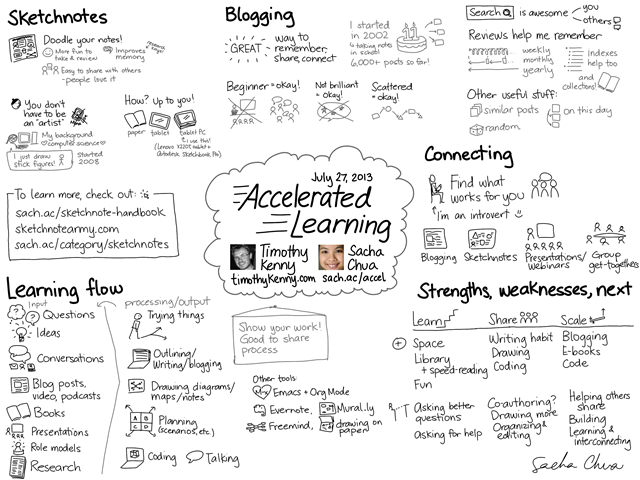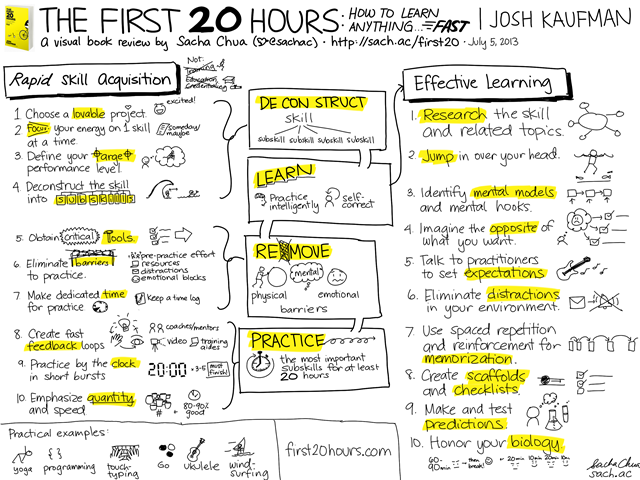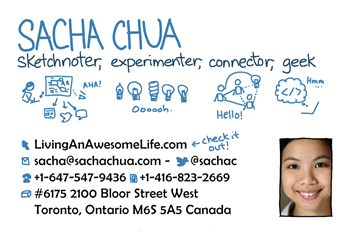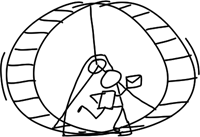Decision review: Seven months at HackLab
Posted: - Modified: | connecting, decision, review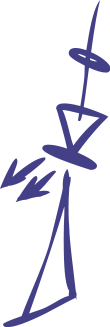
It’s been a little over half a year since I signed up for a membership at HackLab, a makerspace and coworking area in Kensington Market. Before I signed up, I thought about the things I would like to be true at the evaluation point for my experiment, which I set at nine months after I signed up (so November 2013). I figured it would be good to do a quick check so that I can adjust things. Here’s what I wrote in February, and how it has matched up so far with my experience:
- I know more about other geeks in Toronto thanks to ambient conversations and helping each other out
- HackLab is full of interesting people. I like dropping by and hanging out at the open houses or during regular days.
- I’m better at asking people for help when I get stuck, and at setting myself tougher challenges knowing that people can help
- I’ve done this a couple of times (keyboard layouts, business questions, web stuff, system administration), although I still need to work on that.
- I’ve dug into some of the more difficult things that are easier to learn with other people who can help me. For example: web development, mobile development, electronics
- Web development and system administration might be good things to focus on. There are lots of other people who are working on similar things.
- I’ve gotten better at sketching ideas, asking other people for feedback, and fleshing out the ones that get people interested
- I drew How to Learn Emacs while I was at HackLab. That was fun. =) I’ve drawn some of the sketchnote lessons here, too.
- I’ve improved serendipity (test different laptop cues to talk? talk to people about what they’re working on?)
- Overhearing stuff works well.
- I go to HackLab 1-2 times a week, and sometimes more often if the weather is great.
- See analysis below
- I’m good at managing my focus (do not disturb / yes, talk to me)
- Background conversations interfere with things like typing practice (Plover/Colemak), but I’m okay with listening to conversations while typing (Dvorak), coding, or drawing. Headphones help a little.
- I’m good at talking to new people and hanging out with the regulars
- Getting there. I feel comfortable around HackLab members and I often have interesting conversations at open houses, particularly over food.
In general, the benefits I’m looking for are:
- Ambient socialization with interesting people
- Ambient exposure to interesting things
- Possible support for learning stuff (ex: Javascript, system administration, Haskell, Python, neural nets, hardware, electronics, 3D printing)
My initial goal was to go to HackLab 1-2 times a week. As of 2013-09-25 (~31 weeks after I joined; I was doing this analysis before the members’ meeting), I have been to HackLab on 41 distinct days. This is within my target range of 31 to 62 visits, and works out to 1.3 visits a week. This is a pleasant surprise, because I started this analysis thinking that I was underusing my HackLab membership compared to my goals. Based on my current attendance, this costs a little less than $10 per visit, which is worth the awesome vegan cooking opportunities / lessons / dinners (Tuesday open houses) and overheard conversations with interesting geeks.
I’m at 66% of the top part of my goal range. What are my current limiting factors, and how can I work around them?
Inertia is powerful and works ways: when I’m home, it’s easy to stay home; when I’m in the middle of working on something interesting on the kitchen table, I don’t want to pack up and bike over. I often sleep in during my non-consulting days, and sometimes I think: “Is it really worth biking downtown for a few hours of hanging out or working?” I’ve also offered to do a couple of extra half-days of consulting each week during September and October, so that limits the number of days when it makes sense to go to HackLab. Besides, introvert mode is pretty comfortable – no distracting conversations, and plenty of good food in the fridge.
So, what could help me make even better use of HackLab? How can I hack my motivation and reward structure to get me out the door?
- Commit to the exercise and treat HackLab as a bonus. At least once a week (Fridays), I will bike for at least 1.5 hours including a mailbox check. I might as well use that biking time to end up at Hacklab, do some stuff, and then take the other 45 minutes on the way back.
- Make Hacklab the centre of my socialization. Instead of setting up separate get-togethers with people, I will funnel people to HackLab’s open house (which I will attend whenever I don’t have other events). If I’m in introvert mode, I will treat the open house as cooking lessons, catch up with people briefly, and relax knowing that people can always chat with other people. If I’m in socialization mode, I will catch up with people.
- Consider small-scale cooking on regular days. Have fun by cooking at HackLab even on non-open house days: merienda? This might be easier once we’ve moved to the new location, with a larger kitchen and a non-drinks fridge.
- On HackLab days, do not open the computer at home in the morning. This gets around the momentum issue. Checking things on the phone is okay, as is working on the computer if something urgent comes up.
What about winter? I’m going to face some motivation challenges when snow makes biking more dangerous and the cold encourages me to stay home. On mild days in winter, I might be able to bike down or TTC down. I can use that as a context switch to write or code. Is it worth $6 to take the TTC down here at least once a week, bringing it to a total cost of $16 or so? Maybe, especially if I move things around so that I’m at HackLab instead of consulting on Tuesdays (or I work remotely on Tuesdays). If I discount winter and consider my membership based solely on my attendance so far, it works out to roughly $15 per day, which is still worth it considering other co-working spaces are $20 for a day pass and don’t offer 24h access, not that I’ve been here at 3 AM. Besides, HackLab does cool things. So yes, I’ll continue throughout winter, and I’ll see if I can get past the activation costs of getting down here by TTC. (Reading time on the subway/streetcar, and travelling during off-peak hours?)
Incidentally, here are the queries that I used to check how many times I’ve been in HackLab:
SELECT COUNT(DISTINCT(DATE_FORMAT(logged, '%Y-%m-%d'))) from access_log where card_id='123-3149'; SELECT MIN(logged) FROM access_log WHERE card_id='123-3149';
Let’s see how this goes!

